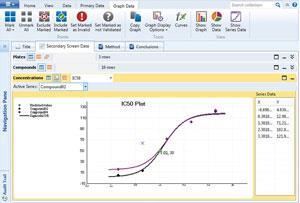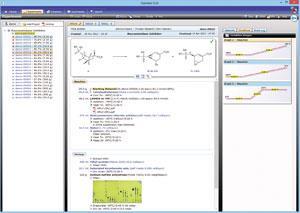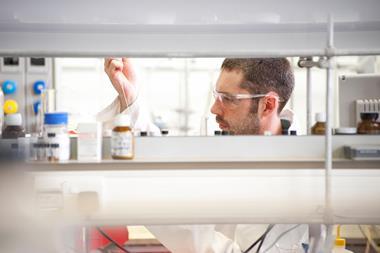
Electronic lab notebooks are changing the way many scientists interact with information. These notebooks, ELNs for short, capture experiment details and data that are fully searchable within and across experiments. They can also automatically provide third-party information to scientists.
Large ELN companies have been active in mergers and acquisitions over the last two or three years, embracing smaller companies to assist them in broadening their portfolio. ‘The biggest vendors have been pulling together tools to provide not only data capture, but also data analysis and data visualisation,’ observes John Trigg, ELN consultant at PhaseFour Informatics. This has allowed them to move towards offering a platform that you can plug into.
‘ELNs are moving away from being discipline-specific and towards a modular approach where you have a generic core, the authoring tool, but with the ability to plug in other types of functionality that would meet chemistry, biology and quality assurance requirements,’ Trigg explains. The biggest players are IDBS, CambridgeSoft (owned by PerkinElmer) and Accelrys, but there are many smaller players offering ELNs with some neat features.
Price is a huge issue for academia
ELNs evolved from desktop tools, dedicated to specific scientific disciplines, or from generic authoring tools, which replicate the paper lab notebook. The result is a motley crew of products, some of which encroach on other informatics tools such as laboratory information management systems (LIMS), scientific data management systems and lab execution systems. The convergence causes some confusion for customers, but in essence people buying an ELN are moving towards a ‘paperless lab’, where the ELN integrates with other lab systems.
Big pharma were the early adopters of ELNs, but small biotechs, academic labs and small companies in general have been more cautious. Also, some ELNs are part of larger packages that could be considered expensive to buy and maintain with IT support.
Accelrys/Contur
In 2008, the Karolinska Institutet (KI) in Stockholm, Sweden, discovered some key problems during an internal audit and decided that paper notebooks were a liability. A lot of the notebooks contained electronic printouts that had been printed and pasted in, which seemed backward. Some research groups at KI were already using ELNs, project manager Cecilia Bjorkdahl explains; usually this occurred after an academic had worked for a biotech or pharma company and come back into the university. ‘They wanted to continue with the e-documentation that they had previously used,’ she explains.
The university teamed up with two medical universities in Sweden and took the plunge, selecting Contur’s iLabber. ‘We had epidemiologists and chemists and everything in between, so we needed something that wasn’t too specific,’ says Bjorkdahl. ‘Also, this is where we got most for our money.’ Price is a huge issue for academia, ELN vendors acknowledge, and KI decided Contur offered value. ‘Some of the other systems we looked at were at least twice as expensive and we were given the impression that they would require a lot more continuous work.’ She says the system they adopted is relatively low maintenance and was one of the easier to handle from an IT perspective. So far, around 1800 people are using the Contur ELN in the institute out of a possible 4500.
Still, there are downsides. ‘It is an out-of-the box product,’ says Bjorkdahl, ‘so that has some disadvantages when it comes to tailoring the system for the diverse groups and it works better for some.’ The varied IT environment caused problems in the beginning and the ELN vendor had to pay more attention to the requirements for Macs, which made up 20–30% of the user interfaces. A client version accessible from a server was available, but the issues spurred the company into developing a web version, agnostic to PC and Mac. There were complaints about the flexibility of the word processing tool, which has since been worked on, and it took time to arrange who should see what and when within the ELN.
Contur was acquired by Accelrys in May 2011, which led to some speculation about the future of their ELN. Thomas Rozlucki of Accelrys says the Contur ELN sits comfortably alongside its own notebook, however. ‘We’ve done significant work to integrate the Contur product with the Accelrys enterprise platform,’ he says. Larger companies might employ the Accelrys platform while contractors, suppliers or partners perhaps opt for the Contur ELN. ‘The Accelrys ELN also has very strong instrument integration, for example, and has a history of being deployed with regulated environments, which differentiates it from the Contur ELN,’ he explains. For compliance reasons, big pharma needs to have instruments integrated with ELNs in analytical and process chemistry. The Accelrys notebook, formerly Symyx, is viewed as a sophisticated, enterprise ELN.
Accelrys offers a discount academic price on its Contur ELN of $120 (~£80) for a 12 month subscription. One hour’s training is sufficient, according to the company, which names Yale University, Carlsberg and Heinz as customers. Chemical structures and reactions are recorded using proprietary chemical drawing tools. Bjorkdahl says it allows them to document the entire research process, including the decision making that takes research in new directions.
IDBS
The chemistry department at the University of Cambridge in the UK has been using IDBS’s E-WorkBook ELNs for a number of years now. IT manager Tim Dickens says the company is seen as a good player in the chemistry and translational medicine space, but says penetration of ELNs into academia has been very patchy. He says the payback is clear, replacing ‘information scribbled into a notebook, the technology used here in Cambridge since Isaac Newton, with an electronic setup that has many benefits such as avoiding experiments being repeated, linking together results from different instruments and locating them for write-up’. The IDBS system is powerful and has proved popular with teams that have invested the time to understand it, he adds.
We are moving away from the traditional ELN into data management, calculation and analysis
The E-workbook, according to IDBS, is highly adaptable to meet the needs of all researchers, from any research biologist to the medicinal or synthetic chemist. It also has a ChemBook application that sits on the E-workbook platform and extends its functionality with specific cheminformatics capabilities that allow one to capture, share, display and search a variety of chemical data types rapidly and securely. Jonathan Davies of IDBS says the basic E-workbook is a ‘product to which we can add particular flavours in order to suit particular domains.’ ChemBook adds the ability to understand the reaction, to search it, and to be able to do workflows appropriate to a chemist.
‘We are moving away from the traditional ELN, which was a replacement for the paper lab notebook, and more into the data management, calculation and analysis area,’ says Davies. Another major trend, noted by multiple ELN vendors, is a focus on ease of use, partly brought on by the easy, intuitive interfaces that many people are accustomed to using on products such as smartphones and tablet computers. ‘ELNs are tools people use every day. So we are concentrating on putting a lot of effort into user interface design to make it as straightforward and simple as possible,’ Davies says.
One downside to the IDBS system, says Dickens, is that it runs on Oracle, ‘quite an expensive package to manage technically and quite complicated. It would be nice if it would use an alternative system such as the open source database system Postgress.’
Another issue in Cambridge was the diversity of devices students were using, with people running Linux, Macs, PCs, their own laptops and more. Dickens would like to see a fully functional web interface, including being able to draw molecules without using different chemical drawing packages. A web-enabled ELN is now available from IDBS and is being improved, he says.
‘Our product is really a PC version, but we are continually moving more of that functionality to the web with a web interface that supports different platforms,’ Davies explains. He admits universities are a challenging environment, but says their system has many advantages over some other offerings. ‘The backend is an Oracle database. The advantage it offers is in security, scalability and performance.’ IDBS’s ChemBook counts Total Petrochemicals and BASF among its customers.
Richard Whitby at Southampton University has looked at a number of ELNs and views the IDBS system as ‘the “best” for academia’ and says his experience is that with the right infrastructure and training it is a good system.
CambridgeSoft
PerkinElmer decided to expand its informatics business following a review about two years ago and acquired CambridgeSoft in March 2011. Its ELN is a market leader and the E-Notebook for Chemistry promises to meet the needs of research chemists in all industries. ‘The E-notebook is the same product whatever industry we sell to. Users then buy additional modules that are application specific. All those bits and pieces fit together into a platform which we call Ensemble for Chemistry,’ says Clive Higgins, vice-president of marketing at PerkinElmer.
‘PerkinElmer is in the business of creating data and it made a strategic move to acquire some businesses and manage that data through ELN and LIMS technologies. The next problem is analysis, interpretation and visualisation of that data,’ he says. The majority of CambridgeSoft clients deploy through PCs and Windows at the front end and Oracle servers at the back end. Harvard University, small biotechs and big pharma are customers.

An example of an embedded component in its chemistry notebook is ChemBioDraw, which allows chemists to create reaction schemes; the ELN automatically generates Iupac names and stoichiometry tables and its chemistry applications promise a central hub for activities that is integrated with chemists’ workflow. Data captured using the ELN can be searched and analysed using ChemBioViz with optional links to Spotfire for powerful visualisation and analysis, the company says.
‘Web-based ELNs tend to run out of capability when you start to get into hundreds of users. Our capabilities and work with Oracle means that our product has proven scalability,’ says Higgins.
Not everyone is enamoured. Whitby, for example, complains that CambridgeSoft have ‘not demonstrated any real engagement in the past and proved very inflexible regards to pilots’.
But Dickens at Cambridge is more positive. ‘We have pockets of people here using the single user version and my understanding is that they find the interface intuitive, providing information in a clean and clear way to get started. And there is a chemical inventory system too. Working in synthetic chemistry you don’t necessarily want all the rich features that IDBS provides.’
Other players
The price of setting up systems from the big players can be in the region of $25,000. That figure puts them in a different league to what small companies or labs might have in mind. Suhaib Siddiqi is vice-president of technology at ZS Genetics, a small genomics biotech in Massachusetts in the US, who has tested a variety of ELNs. Siddiqi is worried that some notebooks demanded too much support: ‘I don’t want my chemists running to IT. We are a start-up. We wanted a reasonably priced, well-designed product,’ he says.
Siddiqi opted for Espresso ELN from ChemBytes, which he says could be installed and used within 15 minutes. The creator is Stefan Abrecht, who worked as a process chemist in industry for 20 years before setting up ChemBytes. Espresso targets organic chemists, including polymer and organometallic chemists. ‘It’s not so much a suite for formulation work,’ says Abrecht, who developed the ELN to be straightforward to install and intuitive to use. It’s available only to work with PCs.

Espresso does not require a server to run, costs $129, and all functionality is built in locally, including reaction substructure searches. It is attractive for those who do not have the resources for server infrastructure, according to Abrecht. ‘What differentiates my application is that it focuses on experiment protocol. It is amazing to me to see products with little textboxes for entering protocol. This is the heart of an ELN, so Espresso ELN features a highly functionalised protocol editor, linked to a materials database, with stoichiometric data kept in the background,’ he says. Espresso can automatically arrange and summarise project experiments, added in no special sequence, into a contiguous graphical reaction scheme. Siddiqi says he would like to see more biological capability added to the system.
Another alternative is an open source ELN; GGA Software Services was chosen to develop, market and distribute Pfizer’s internal ELN as an open source version, Indigo. GGA had worked with Pfizer to support and maintain the original ELN for several years. Indigo is described as highly configurable and extensible. It supports Linux, Windows and Mac OS X systems.
‘It has been developed with the input of thousands of Pfizer chemists over many years,’ says GGA’s Richard Golob, ‘so it’s a tested and proven platform.’ He says GGA will help maintain, customise and configure the ELN for companies. Golob sees big opportunities for Indigo to be used by external partners, labs and contractors working with big pharma, offering a low-cost chemistry ELN. Siddiqi considered Indigo but thought it too complex for what they needed, but it may suit others.
There are dozens of other options. Agilent, an instrument company, came into the ELN space through an acquisition and offers a product, OpenLAB ELN, that can deal with data coming off instruments. Another is Dotmatics, which has come from the arena of data analysis and added an ELN to their portfolio as a means of capturing and analysing data. Sciency ELN from RURO is a further option. The company describes it as a scalable, integrated research environment for managing and sharing data that can streamline laboratory processes. Finally, there are other open-source software options developed by the Universities of Southampton and Manchester (LabTrove and Myexperiment).
Big picture
A number of ELN vendors offer free trials and this is certainly worth considering when deciding on an ELN platform. Cost and sophistication vary, but the big vendors do not differ enormously in price, says Trigg. ‘Most of the major systems around now are quite sophisticated but to tailor them to your particular needs can require configuration,’ he adds, which can get costly and complicated. Trigg advises prospective customers to ask for an estimated total cost of ownership over a period of time, say five or 10 years. He is certain ELNs will elbow the paper notepad out of the lab over the next decade.
‘I can’t believe that over the next 10 years any lab will still want to use paper because of the drive towards integrated end-to-end business processes with seamless links to information flows,’ he says. ‘There’s a sort of inevitability about it all.’
Anthony King is a science writer based in Dublin, Ireland
Following the trend
Michael Elliot of consulting group Atrium Research talks to Chemistry World about the market trends in ELNs
Q. What specific trends have emerged in the ELN market over the last few years?
There are several trends, both from a market and product perspective. In biopharma, the market is definitely moving much more downstream into areas such as analytical chemistry, biologics development and quality. In other segments, the uptake of ELN in sectors such as food and beverage, consumer products, and chemical manufacturing (non-pharma) is accelerating, matching the trends we saw in LIMS back in the late 1980s and early 1990s.
Both of those trends are pushing vendors into different dimensions - trying to simplify products to meet a broader audience while at the same time adding additional functionality, such as sample and results tracking needed for development and quality. This trend for convergence of LIMS-like functionality into ELN can actually increase product complexity.
Q. How have the needs of small companies and/or academia been met by ELN vendors?
I would separate small companies from academia here. Small companies have embraced ELN from the very beginning and have a wide variety of options to select from. Academia is a different beast where adoption is low. While large institutions have implemented ELN, this is a small portion of the overall academic market resulting in less than a 10% adoption rate.
The larger issue in academia is a general unwillingness to adopt ELN very early on in teaching
Issues are quite complex in this sector. Most institutions do not have the need for the intellectual property protection tools provided by most products. The need is from a collaboration perspective, and there are a wide number of tools that are ‘ELN-like’ that can be used – some even free. So, while some groups do not use ELNs they may use other tools which provide the necessary functionality.
The larger issue I see in academia is a general unwillingness to change and adopt ELN very early on in teaching. Yes, there are some issues with cost, but several providers offer very low-priced solutions for educational purposes. It is more from a resistance to understand the importance of the technology – particularly for synthetic chemistry – in future employers. We must train students in the technology they will be using in the future and learn ways to improve it, rather than train them via obsolete paper paradigms.
Q Have new ELN vendors that are particularly innovative come out in the last two or three years?
Honestly, in the last two to three years, I have not been struck by any product which is particularly novel or is so innovative that they really stand above the fray. The last few years have been evolutionary changes with additional capabilities and work on some new user interfaces.
Atrium Research publishes a comprehensive review of the ELN market.












No comments yet